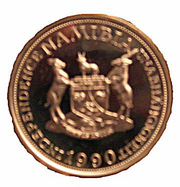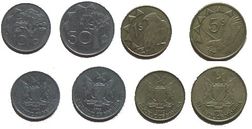Namibian dollar
| Namibian dollar | |||
|---|---|---|---|
|
|||
| ISO 4217 Code | NAD | ||
| User(s) | |||
| Inflation | 10.3% | ||
| Source | The World Factbook, 2008 est. | ||
| Pegged with | South African rand at par | ||
| Subunit | |||
| 1/100 | cent | ||
| Symbol | N$ | ||
| Coins | 5, 10, 50 cents, $1, $5 | ||
| Banknotes | $10, $20, $50, $100, $200 | ||
| Central bank | Bank of Namibia | ||
| Website | www.bon.com.na | ||
The dollar (currency code NAD) has been the currency of Namibia since 1993. It is normally abbreviated with the dollar sign $, or alternatively N$ to distinguish it from other dollar-denominated currencies. It is divided into 100 cents.
For earlier Namibian currency, see German South West African mark.
Contents |
History
The dollar replaced the South African rand, which had been the country's currency while it was under South African rule as South-West Africa 1920-1990. The rand is still legal tender, as the Namibian dollar is linked to the South African rand and can be exchanged on a one-to-one basis locally. Namibia was also part of the Common Monetary Area from independence in 1990 until introduction of the dollar in 1993.
In 1990, moves were under way to replace the rand with a new Namibian currency. The name kalahar was proposed, as the Kalahari Desert is located in eastern Namibia. The name of Namibia's central bank was going to be known as the Namibia Reserve Bank. Denominations of this planned currency included 2, 5, 10, and 20 kalahar. (Note: There were two different designs for the 20 kalahar specimen notes.) However, these plans came to nothing, but some specimen notes were printed in a range of denominations.
The Bank of Namibia issued the first banknotes on 15 September 1993, and during December of that year, also issued the first national coins.
Coins
Coins in circulation
- 5 cents
- 10 cents
- 50 cents
- $1
- $5
Years of mintage are 1993, 1996, 1998, 2000, 2002, 2008 and 2009. The cent coins are made of nickel plated steel and the dollar coins of brass
Banknotes

Banknotes in circulation
- $10
- $20
- $50
- $100
- $200
Hendrik Witbooi, once a Namaqua chief and instrumental in leading the revolts against German rule at the turn of the 20th century, is depicted on all banknotes.
Dollar or mark?

During the planning phase of the introduction of a new national currency replacing the South African rand, the newly founded Bank of Namibia minted a proof series of coins denominated in dollars as well as in marks, for the consideration of the Namibian Ministry of Finance. The decision then fell in favour of the name ‘dollar’ for the new currency.
The proof series consisted of four different coins: 1 mark, 1 dollar (both in copper/nickel), 10 marks and 10 dollars (both in silver). The recto of the mark pieces shows a sitting lion where the dollar pieces depict a Bushman with bow and arrow. All recto sides bear the indication of denomination as well as the remark ‘PROBE’/‘ESSAI’ (proof). The verso of the 1-mark/1-dollar pieces shows Namibia’s former coat of arms surrounded by the inscription ‘NAMIBIA’, the year (1990) and two ears of corn. The ten-mark/ten-dollar pieces bear the inscription ‘INDEPENDENCE’/‘UNABHÄNGIGKEIT’ (G. ‘independence’) instead of the ears.
There was also a series of Namibian pattern coins denominated in Rand dated 1990.
These pattern coins are listed in the 2005 edition of Krause's 'Unusual World Coins'.
| Current NAD exchange rates | |
|---|---|
| From Google Finance: | AUD CAD CHF EUR GBP HKD JPY USD |
| From Yahoo! Finance: | AUD CAD CHF EUR GBP HKD JPY USD |
| From XE.com: | AUD CAD CHF EUR GBP HKD JPY USD |
| From OANDA.com: | AUD CAD CHF EUR GBP HKD JPY USD |
Half Pounds
The Namibian dollar is not a true dollar in the sense that it is descended directly from the Spanish pieces of eight, as is the case with the US dollar, the Canadian dollar, and the East Caribbean Dollar. The Namibian dollar is essentially a half pound sterling. The Namibian dollar is an off-shoot of the South African rand, and when South Africa decided to adopt the decimal system in 1961, it decided to use the half pound unit as opposed to the pound unit of account. Other examples of dollars that are not true dollars for this same reason are, the Cayman Islands dollar, the Australian dollar, the New Zealand dollar, the Solomon Islands dollar, the Fiji dollar, the Jamaican dollar, the Rhodesian dollar, and the Zimbabwe dollar.
Examples of dollars that are directly related to the original Spanish dollar unit are the US dollar, the Canadian dollar, the Newfoundland dollar, the East Caribbean dollar, the Belize dollar, the Guyanese dollar, the Bermuda dollar, the Bahamian dollar, the Trinidad and Tobago dollar, the Barbados dollar, the Hong Kong dollar, the Straits dollar, the Malayan dollar, the Singapore dollar, and the Brunei dollar.
See also
- Economy of Namibia
External links
| Preceded by: South African rand Reason: independence Ratio: at par |
Currency of Namibia 1993 – Concurrent with: South African rand |
Succeeded by: Current |
|
|||||||||||
|
||||||||||||||||||||||||||
|
|||||||||||||||||
